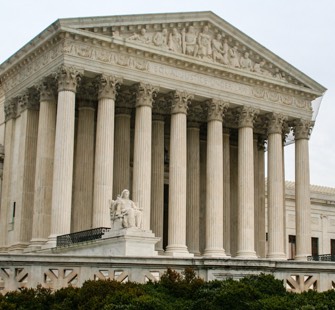Supreme Court will decide whether BRI or Phillips standard applies to IPR claims
 During patent examination, pending patent claims are given the broadest reasonable interpretation (“BRI”) that is consistent with the specification, as would be understood by one of ordinary skill in the art. See Phillips v. AWH Corp., 415 F.3d 1303, 1316 (Fed. Cir. 2005).
During patent examination, pending patent claims are given the broadest reasonable interpretation (“BRI”) that is consistent with the specification, as would be understood by one of ordinary skill in the art. See Phillips v. AWH Corp., 415 F.3d 1303, 1316 (Fed. Cir. 2005).
The Patent Office applies the broadest reasonable interpretation in virtually all circumstances. It is, however, true that at least one situation where the Patent Office does not use broadest reasonable interpretation is when a reexamination of a patent is undertaken and reexamination will not be concluded until after the patent term has expired. The position of the USPTO is that, in this situation, a patent could not be changed because the term has expired; therefore, the only remaining “life” a patent has would be in litigation because the statute of limitations for a patent infringement action is six years. Thus, the USPTO applies the Phillips standard. (Further discussion of this advanced topic goes beyond the scope of this article, which is intended to be a primer on the broadest reasonable interpretation standard.)
Supreme Court accepts Inter Partes Review Appeal
 On Friday, January 15, 2016, the United States Supreme Court accepted the petitioner’s request to hear Cuozzo Speed Technologies v. Lee, a case that will now require the Court to address two questions about inter partes review (IPR) proceedings.
On Friday, January 15, 2016, the United States Supreme Court accepted the petitioner’s request to hear Cuozzo Speed Technologies v. Lee, a case that will now require the Court to address two questions about inter partes review (IPR) proceedings.
IPR proceedings were created by the America Invents Act (AIA), which was signed into law by President Barack Obama on September 16, 2011. IPR and the other two forms of post-grant challenge to issued patents — Post Grant Review (PGR) and Covered Business Method (CBM) Review — did not become available as a procedure to challenge patents until September 16, 2012. Thus, these proceedings are quite new and Cuozzo will be the first opportunity for the Supreme Court to weigh in on these controversial administrative proceedings.
According to the statute, “[a] person who is not the owner of a patent may file a petition to institute an inter partes review of the patent.” 35 U.S.C. 311(a). Significantly for this appeal, the statute also says: “The determination by the Director whether to institute an inter partes review under this section shall be final and nonappealable.” 35 U.S.C.314(d). Additionally, although the statute is silent as to the proper claim construction standard to use in post grant proceedings, the United States Patent and Trademark Office (USPTO) has decided to apply the familiar standard used elsewhere throughout the Office, which is the broadest reasonable interpretation (BRI) rather than the so-called “Phillips standard” that is used in district court litigation and narrowly construes claims in an already issued patent. (more…)
02.1.16 | Inter Partes Review, Patent Issues, Supreme Court Cases, USPTO | Gene Quinn


No Comments
03.9.16 | Claim Construction and Markman Hearings, Inter Partes Review, Patent Issues, posts, Supreme Court Cases | Gene Quinn